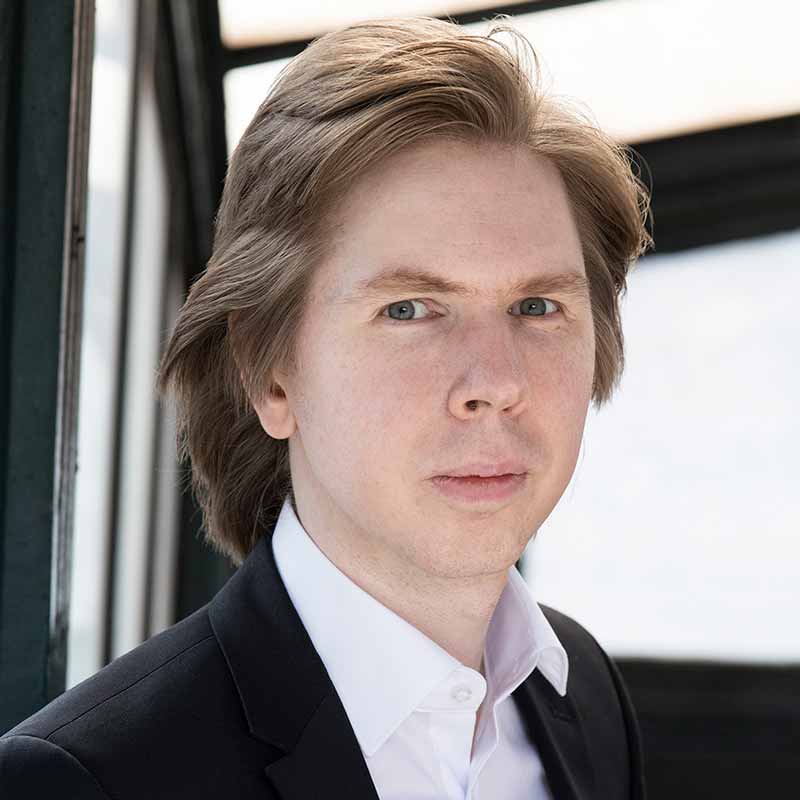by Mike Telin

I spoke to Pohjonen over Zoom from Minneapolis where he was performing Mendelssohn’s Concerto for Violin and Piano with Osmo Vänskä and the Minnesota Orchestra. I began by asking him to share his insights on Debussy’s Cello Sonata, which he will perform with Jonathan Swensen on June 30.
Juho Pohjonen: The interaction between the cello and the piano is so intimate. The music is like an exchange of ideas and that is one of the most rewarding aspects of the piece.
Debussy was able to create new colors without resorting to any fancy techniques like playing inside the piano or things like that. In a way it’s quite simple and concise. It’s a short work of less than 15 minutes, but every note means something.
Mike Telin: That same night you’ll play Franck’s Piano Trio No. 1 with Jonathan and violinist Stephen Waarts. What are your thoughts about this work?
JP: In general I really love Franck’s music — the violin sonata and the piano quintet — and I have played his Prelude, Choral and Fugue. It’s all great music. I think he’s an interesting composer — he has this almost fragile emotional side which is both optimistic and melancholic. It’s a symphonic kind of writing.
Honestly, I really didn’t know that this piano trio existed. It is his first major work, Opus 1. You can hear Franck’s symphonic side in the music as well as his emotional side. It’s more violent than I would have expected — he has actually written “with violence,” in the score. I wasn’t expecting that from Franck, but it kind of makes sense within the context. I think he was criticized because it is pretty repetitive. But it is colorful and I can’t wait to play it — it sparks my interest to learn more about his early works.
MT: Anna Thorrvaldsdoittir’s In the light of Air (July 1) is a complex piece.
JP: It is, but looking at the music it is also an intimate work: the dynamics are very soft nearly all of the time.
I’ve had some experience with the music of Icelandic composers — I recently played Daniel Bjarnason’s Concerto — and this piece shares some of the same stylistic ideas. You can hear that they are basically from the same culture: they have the same sense of mystery. Her approach is quite fresh, but it isn’t the modern style that continues in the tradition of Boulez for example. It’s very natural.
MT: The piece calls for “prepared piano.”
JP: I have to do lots of things that I wouldn’t normally do, and there is so much stuff that I have to buy. I need to use an ebow, which is mostly used with a guitar. It vibrates a string so you get a faint note that lasts forever. I need to use soft yarn mallets and I need to make a superball mallet — a superball glued to the stick so it keeps shaking on the piano strings. I also need some fishing line, paper clips, and I have to add screws to some of the strings. So I can’t wait to practice, and hope I don’t destroy the piano in the process. But I think experiencing the piece live will be really effective.
MT: Changing topics, I’m curious to learn more about your MyPianist app.
JP: It’s a virtual piano app that accompanies people while they’re playing chamber music and concertos. The app reacts in real time to your playing so basically it’s a virtual collaborative pianist.
MT: It’s reminding me of the old Music Minus One records.
JP: I know that those existed — this is more of an advanced version of that.
MT: How have musicians reacted to it?
JP: It’s been used a lot. Of course during that pandemic, because of the lockdowns it was useful for many people. But it’s still being used quite a bit.
MT: I noticed that you have quite a long list of repertoire that is available for the app?
JP: Right now there are more than 300 pieces. I keep adding them — basically every week there is a new piece.
MT: Your brother Joonas is also involved in the project.
JP: He’s also a pianist and knows a lot of repertoire, especially chamber music. But I’m the one who is doing all the coding.
MT: When did you learn how to code?
JP: When I was a kid. But I was just playing around and having fun with computers. Then, around ten years ago I thought that maybe there was something I could do with my programming skills that would actually be useful to people. So then I came up with this idea.
My first instrument was violin and for quite a long time I played both violin and piano. For me, the best moments I had playing the violin were when I had a pianist to play with.
MT: How long did it take to develop?
JP: It took a lot of time. It was about seven years before I could really use it and I’m still working on it.
MT: You are making many people’s lives easier.
JP: It is a good practice tool. People are joking that I am making myself redundant, but it will never replace a live pianist. And of course playing with a live person is more rewarding.
Published on ClevelandClassical.com June 28, 2022.
Click here for a printable copy of this article



